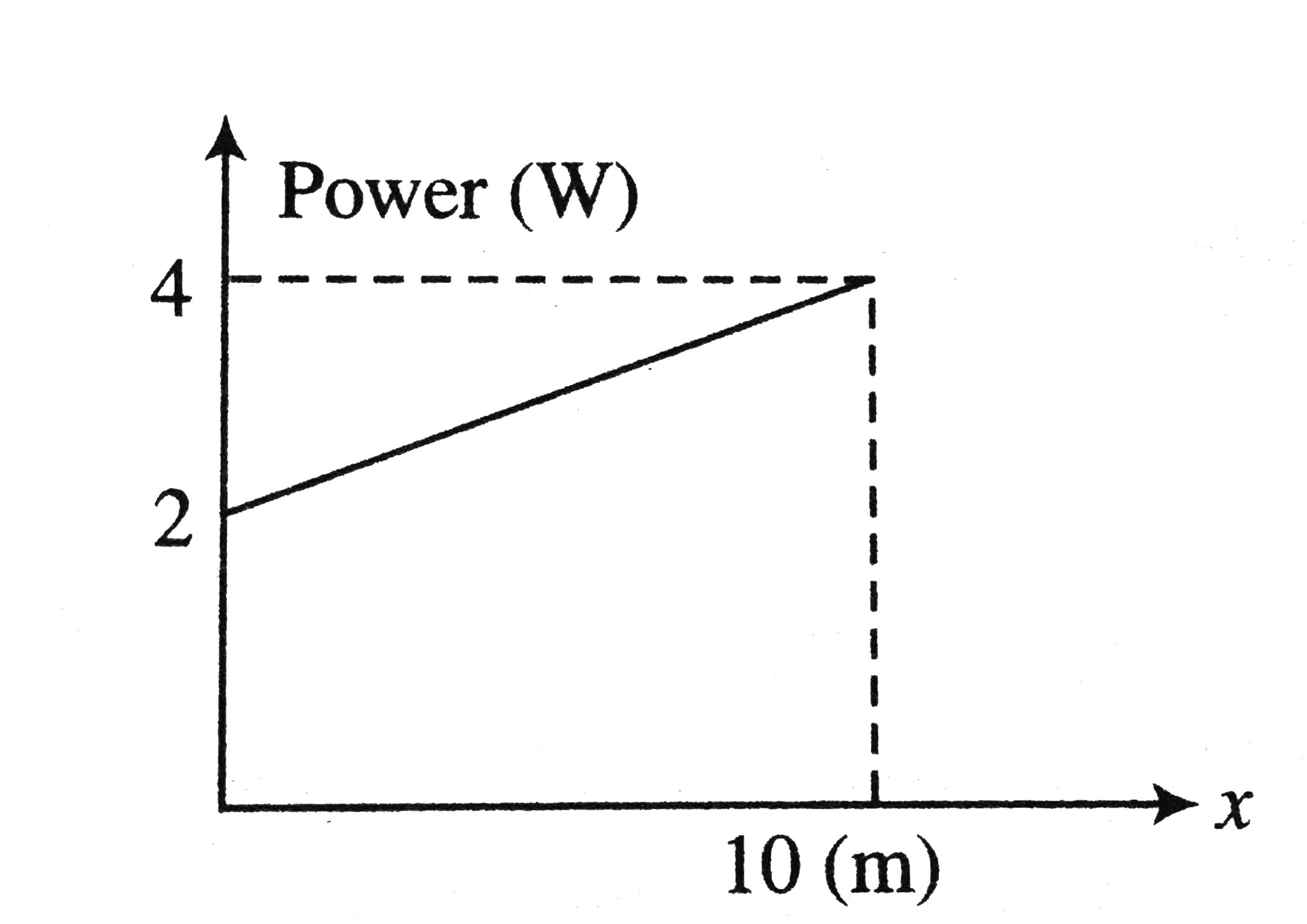In a standing wave experiment , a 1.2−kg horizontal rope is fixed in place at its two ends (x=0andx=2.0m) and made to oscillate up and down in the fundamental mode , at frequency of 5.0Hz. At t=0 , the point at x=1.0m has zero displacement and is moving upward in the positive direction of y−aξs with a transverse velocity 3.14m/s.
Tension in the rope is
60N
100N
120N
240N
The correct Answer is:D
To solve the problem, we need to find the tension in the rope based on the given information about the standing wave. Let's break down the solution step by step:
Step 1: Understand the Setup
We have a horizontal rope of mass m=1.2kg fixed at both ends (at x=0 and x=2.0m). The rope is vibrating in the fundamental mode at a frequency of f=5.0Hz.
Step 2: Determine the Length of the Rope
The length L of the rope is given as:
L=2.0m
Step 3: Calculate the Wavelength
In the fundamental mode of a standing wave, the wavelength λ is related to the length of the rope by:
L=λ2⟹λ=2L
Substituting the value of L:
λ=2×2.0m=4.0m
Step 4: Calculate the Wave Speed
The speed v of the wave on the rope can be calculated using the formula:
v=f⋅λ
Substituting the values of f and λ:
v=5.0Hz×4.0m=20.0m/s
Step 5: Calculate the Mass per Unit Length
The mass per unit length μ of the rope is given by:
μ=mL
Substituting the values of m and L:
μ=1.2kg2.0m=0.6kg/m
Step 6: Relate Wave Speed to Tension
The wave speed is also related to the tension T in the rope and the mass per unit length μ by the formula:
v=√Tμ
Squaring both sides gives:
v2=Tμ⟹T=v2⋅μ
Substituting the values of v and μ:
T=(20.0m/s)2⋅0.6kg/m=400⋅0.6=240N
Final Answer
The tension in the rope is:
240N
---
We have a horizontal rope of mass m=1.2kg fixed at both ends (at x=0 and x=2.0m). The rope is vibrating in the fundamental mode at a frequency of f=5.0Hz.
The length L of the rope is given as:
L=2.0m
In the fundamental mode of a standing wave, the wavelength λ is related to the length of the rope by:
L=λ2⟹λ=2L
Substituting the value of L:
λ=2×2.0m=4.0m
The speed v of the wave on the rope can be calculated using the formula:
v=f⋅λ
Substituting the values of f and λ:
v=5.0Hz×4.0m=20.0m/s
The mass per unit length μ of the rope is given by:
μ=mL
Substituting the values of m and L:
μ=1.2kg2.0m=0.6kg/m
The wave speed is also related to the tension T in the rope and the mass per unit length μ by the formula:
v=√Tμ
Squaring both sides gives:
v2=Tμ⟹T=v2⋅μ
Substituting the values of v and μ:
T=(20.0m/s)2⋅0.6kg/m=400⋅0.6=240N
The tension in the rope is:
240N
Topper's Solved these Questions
- SUPERPOSITION AND STANDING WAVESBook:CENGAGE PHYSICSChapter:SUPERPOSITION AND STANDING WAVESExercise:Integer
Explore 9 Videos
- SUPERPOSITION AND STANDING WAVESBook:CENGAGE PHYSICSChapter:SUPERPOSITION AND STANDING WAVESExercise:Multiple Correct Answers Type
Explore 5 Videos
- SUPERPOSITION AND STANDING WAVESBook:CENGAGE PHYSICSChapter:SUPERPOSITION AND STANDING WAVESExercise:Assertion - Reasoning
Explore 6 Videos
- SOUND WAVES AND DOPPLER EFFECTBook:CENGAGE PHYSICSChapter:SOUND WAVES AND DOPPLER EFFECTExercise:Integer
Explore 16 Videos
- THERMODYNAMICSBook:CENGAGE PHYSICSChapter:THERMODYNAMICSExercise:24
Explore 1 Video
Similar Questions
A certain spring has a linear mass density of 0.25kgm−1 and is stretched with a tension of 25 N. One end is given a sinusoidal motion with frequnecy 5 Hz and amplitude 0.01 m. At time t=0, the other end has zero displacement and is moving in the positive y-direction.
(i) Find the wave speed, amplitude, angular frequnecy, period, wavelength and wave number.
(ii) Write a wave function representing the wave.
(iii) Find the position of the point at x=0.25m at time t=0.1s.
View SolutionA wire stretched between two rigid supports vibrates in its fundamental mode with a frequency of 45Hz. The mass of the wire is 3.5×10−2kg and its linear mass density is 4.0×10−2kgm−1. What is (a) the speed of a transverse wave on the string , and (b) the tension in the string?
View Solution
Knowledge Check
In a standing wave experiment , a 1.2−kg horizontal rope is fixed in place at its two ends (x=0andx=2.0m) and made to oscillate up and down in the fundamental mode , at frequency of 5.0Hz. At t=0 , the point at x=1.0m has zero displacement and is moving upward in the positive direction of y−aξs with a transverse velocity 3.14m/s.
Speed of the participating travelling wave on the rope isA6m/sB15m/sC20m/sD24m/sIn a standing wave experiment , a 1.2−kg horizontal rope is fixed in place at its two ends (x=0andx=2.0m) and made to oscillate up and down in the fundamental mode , at frequency of 5.0Hz. At t=0 , the point at x=1.0m has zero displacement and is moving upward in the positive direction of y−aξs with a transverse velocity 3.14m/s.
What is the correct expression of the standing wave equation ?A(0.1)sin(π/2)xsin(10π)tB(0.1)sin(π)xsin(10π)tC(0.05)sin(π/2)xcos(10π)tD(0.04)sin(π/2)xsin(10π)tLength of 0.3m wire vibrates in fundamental mode at frequency 480 Hz. The velocity of sound wave in air is
A330 m/sB320 m/sC330 m/sD288 m/s
Length of 0.3 m wire vibrates in fundamental mode at frequency 480Hz. Then the velocity of sound wave in air is
View SolutionA particle A of mass 10/7kg is moving in the positive direction of x−aξs. At initial position x=0, its velocity is 1ms−1, then its velocity at x=10m is (use the graph given)

View SolutionA wave travelling in positive X-direction with A=0.2m has a velocity of 360m/sec if λ=60m, then correct exression for the wave is
View SolutionA wave travelling in positive X-direction with A=0.2m has a velocity of 36m/sec if λ=60m, then correct expression for the wave is
View SolutionA wave travelling in positive X-direction with A=0.2m has a velocity of 360m/sec . If λ=60m , then correct expression for the wave is
View Solution

